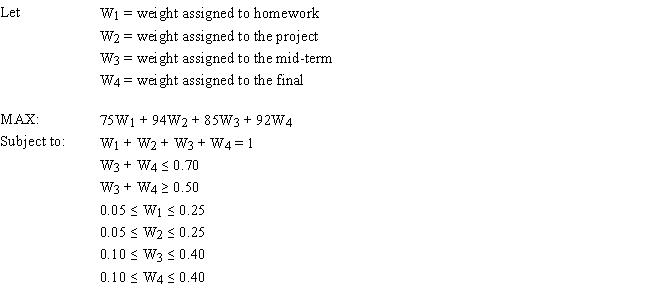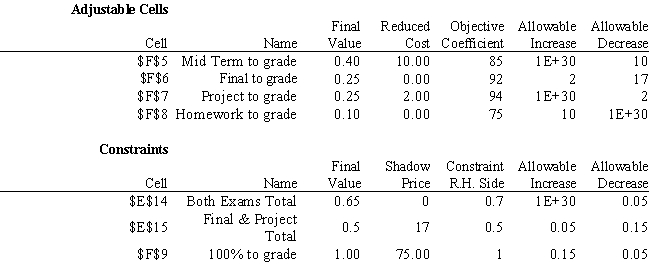Exhibit 4.2
The following questions correspond to the problem below and associated Analytic Solver Platform sensitivity report.
Robert Hope received a welcome surprise in this management science class; the instructor has decided to let each person define the percentage contribution to their grade for each of the graded instruments used in the class. These instruments were: homework, an individual project, a mid-term exam, and a final exam. Robert's grades on these instruments were 75, 94, 85, and 92, respectively. However, the instructor complicated Robert's task somewhat by adding the following stipulations:  The following LP model allows Robert to maximize his numerical grade.
The following LP model allows Robert to maximize his numerical grade. 

-Refer to Exhibit 4.2. Constraint cell F9 corresponds to the constraint, W1 + W2 + W3 + W4 = 1, and has a shadow price of 75. Armed with this information, what can Robert request of his instructor regarding this constraint?
Definitions:
Manufacturing Overhead
The indirect production costs that are not directly associated with the manufacturing of products, such as utilities and rent for the manufacturing facility.
Predetermined Overhead Rate
A computed rate used for applying overhead costs to products or job orders, calculated before the period begins based on estimated costs.
Machine-Hours
The total hours that machinery is operating during a specific period, often used for allocating manufacturing overhead costs.
Predetermined Overhead Rate
An estimated rate used to assign manufacturing overhead costs to individual units of production.
Q6: Implementing solutions to problems involves people and
Q12: Refer to the above table. What is
Q21: A financial planner wants to design a
Q33: The feasible region for the pure ILP
Q75: The main difference between linear (LP) and
Q92: Draw the network representation of this LP
Q100: Refer to the above information. Using i
Q177: The slope of the typical production possibilities
Q198: Any point inside the production possibilities curve
Q251: The slope of a straight line can